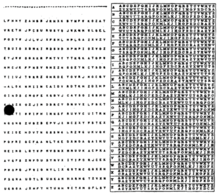|
Beaufort cipher
The Beaufort cipher, created by Sir Francis Beaufort, is a substitution cipher similar to the Vigenère cipher, with a slightly modified enciphering mechanism and tableau.[1] Its most famous application was in a rotor-based cipher machine, the Hagelin M-209.[2] The Beaufort cipher is based on the Beaufort square which is essentially the same as a Vigenère square but in reverse order starting with the letter "Z" in the first row,[3] where the first row and the last column serve the same purpose.[4] Using the cipher To encrypt, first choose the plaintext character from the top row of the tableau; call this column P. Secondly, travel down column P to the corresponding key letter K. Finally, move directly left from the key letter to the left edge of the tableau, the ciphertext encryption of plaintext P with key K will be there. For example if encrypting plain text character "d" with key "m" the steps would be:
To decrypt, the process is reversed. Unlike the otherwise very similar Vigenère cipher, the Beaufort cipher is a reciprocal cipher, that is, decryption and encryption algorithms are the same. This obviously reduces errors in handling the table which makes it useful for encrypting larger volumes of messages by hand, for example in the manual DIANA crypto system, used by U.S. Special Forces during the Vietnam War (compare DIANA-table in the image). In the above example in the column with "m" on top one would find in the reciprocal "d" row the ciphertext "K". The same is true for decryption where ciphertext "K" combined with key "m" results in plaintext "d" as well as combining "K" with "d" results in "m". This results in "trigram" combinations where two parts suffice to identify the third. After eliminating the identical trigrams only 126 of the initial 676 combinations remain (see below) and could be memorized in any order (e.g. AMN can be memorized as "man" and CIP as "pic") to speed up encoding and decoding.[5] AAZ ABY ACX ADW AEV AFU AGT AHS AIR AJQ AKP ALO AMN
BBX BCW BDV BEU BFT BGS BHR BIQ BJP BKO BLN BMM BZZ
CCV CDU CET CFS CGR CHQ CIP CJO CKN CLM CYZ
DDT DES DFR DGQ DHP DIO DJN DKM DLL DXZ DYY
EER EFQ EGP EHO EIN EJM EKL EWZ EXY
FFP FGO FHN FIM FJL FKK FVZ FWY FXX
GGN GHM GIL GJK GUZ GVY GWX
HHL HIK HJJ HTZ HUY HVX HWW
IIJ ISZ ITY IUX IVW
JRZ JSY JTX JUW JVV
KQZ KRY KSX KTW KUV
LPZ LQY LRX LSW LTV LUU
MOZ MPY MQX MRW MSV MTU
NNZ NOY NPX NQW NRV NSU NTT
OOX OPW OQV ORU OST
PPV PQU PRT PSS
QQT QRS
RRR
Algebraic descriptionThe Beaufort cipher can be described algebraically. For example, using an encoding of the letters A–Z as the numbers 0–25 and using addition modulo 26, let be the characters of the message, be the characters of the cipher text and be the characters of the key, repeated if necessary. Then Beaufort encryption can be written,
Similarly, decryption using the key ,
Decrypting as a Vigenere cipherDue to the similarities between the Beaufort cipher and the Vigenère cipher it is possible, after applying a transformation, to solve it as a Vigenère cipher. By replacing every letter in the ciphertext and key with its opposite letter (such that 'a' becomes 'z', 'b' becomes 'y' etc.; i.e. an Atbash-transformation) it can be solved like a Vigenère cipher. Distinguished from 'variant Beaufort'The Beaufort cipher should not be confused with the "variant Beaufort" cipher. In variant Beaufort, encryption is performed by performing the decryption step of the standard Vigenère cipher, and likewise decryption is performed by using Vigenère encryption. References
|







